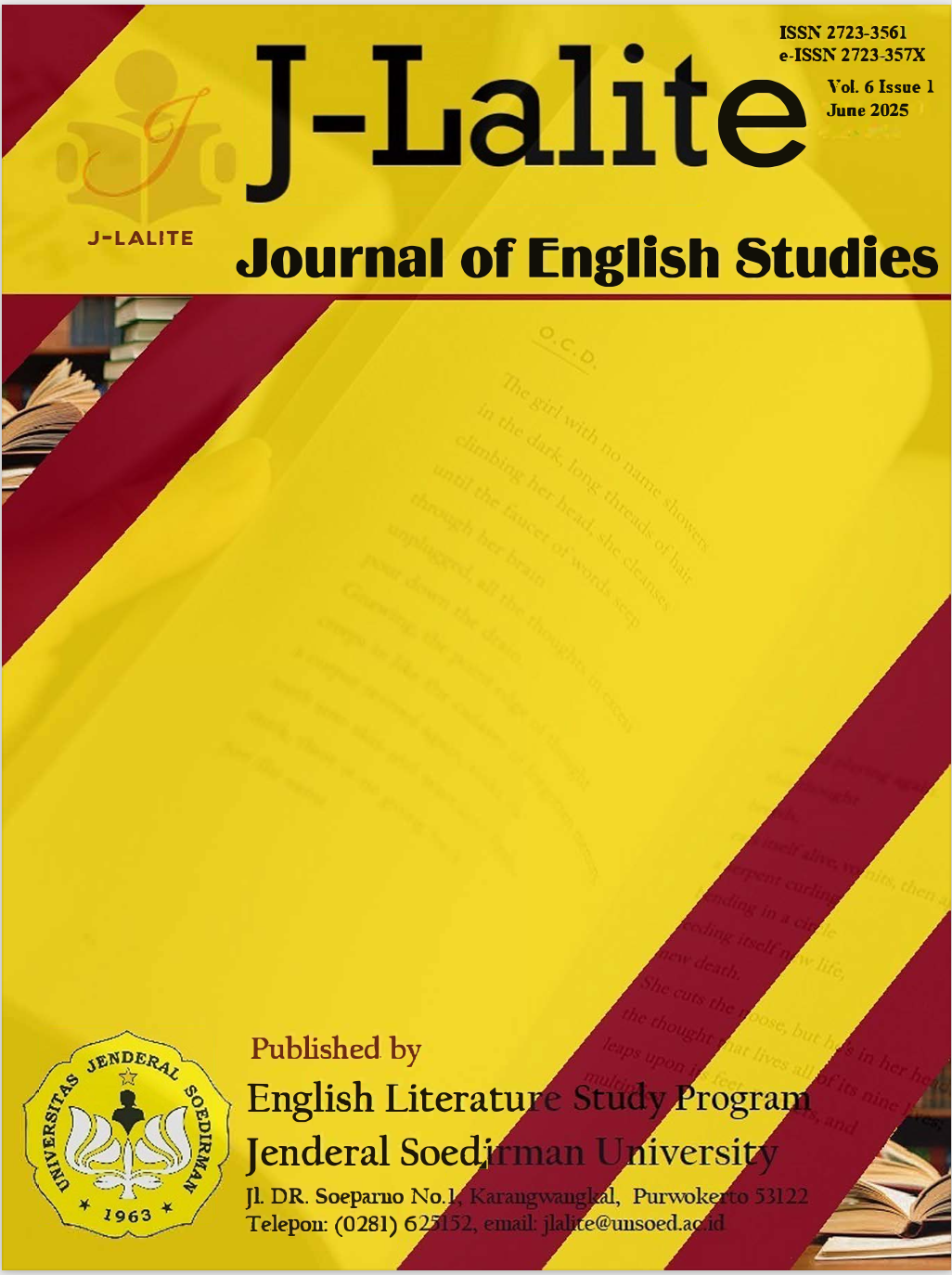Adaptation of Twilight Novel to Film: from Feminism to the Idea of Masculinity
Abstrak
Adaptation studies are interesting in discussing literary works and films. It is because adapting a scholarly work, like a novel or play, for the big screen is extremely difficult and requires a high level of ability. One of the literary works adapted into a film is the novel Twilight, by Stephanie Meyer. In the adaptation of the novel to the Twilight film, there are many reductions of the story, and additional scenes that are not in the novel. By using the theories of adaptation, feminism, and masculinity, this study analyzes the changes in the theme of feminism in the novel to masculinity in the film, caused by differences in ideas between the novelist and the filmmaker. By applying the comparative method, this study aims to compare the changes in the notion of feminism in the Twilight novel with the idea of masculinity in its film adaptation, and to reveal the motives behind it. The analysis shows that the Twilight film adaptation strategically shifts the feminist themes in the novel version by centering on traditional masculinity, a deliberate choice to appeal to its target audience, particularly teenage girls.
Referensi
Burwell, C. (2008). Carter Burwell’s Notes. Retrieved July 8, 2015, from https://www.carterburwell.com/ website: https://www.carterburwell.com/projects/Twilight.shtml
Chakrabarti, R., & Singh, D. R. (2017). Celebrating the Feminine Self: An Understanding of Stephenie Meyer’s Twilight. Journal of English Language and Literature, 8(3), 669–672. https://doi.org/10.17722/jell.v8i3.337
Corliss, R. (2009). Box Office: New Moon Takes a Hit on The Blind Side. Retrieved November 29, 2024, from https://time.com/ website: https://time.com/archive/6910529/box-office-new-moon-takes-a-hit-on-the-blind-side/
Damono, S. D. (2014). Alih Wahana. Jakarta: Editum.
Dinurriyah, I. S. (2016). The Meaning of Beauty through A Woman Image in Stephenie Meyer’s Twilight. NOBEL: Journal of Literature and Language Teaching, 7(2), 82–97. https://doi.org/10.15642/nobel.2016.7.2.82-97
Edmunds, A. (2024). Revamping The Gaze: How Twilight Hosts the Conditions for Female Spectatorship. University of Michigan.
Giannetti, L. D. (2018). Understanding Movies (Fourteenth). Boston: Pearson.
Hairi, S. (2019). the Portrait of Character Building in ‘Twilight’ Film Script Through Ethical Values. Journal of English for Academic and Specific Purposes (JEASP), 2(1), 33–47. https://doi.org/10.18860/jeasp.v2i1.7262
Hardwicke, C. (2008). Twilight. United States: Summit Entertainment.
Hartati, Y. A., Kustanti, D., & Permanaludin, U. (2024). Application of an Adaptation Approach Through Narrative Comparisons in the Novel and Film Twilight. Call, 6(1), 27–32. https://doi.org/10.15575/call.v6i1.24074
Hutcheon, L., & O’Flynn, S. (2013). A Theory of Adaptation. In Comparative Literature Studies. New York: Routledge. https://doi.org/10.2307/complitstudies.45.3.0404
Leitch, T. (Ed.). (2017). The Oxford Handbook of Adaptation Studies. New York: Oxford University Press. https://doi.org/10.5817/bl2017-1-9
Marciniak, M. (2007). The Appeal of Literature-to-Film Adaptations. Lingua Ac Communitas, 17, 59–67.
Meyer, S. (2005). Twilight. New York: Little, Brown and Companny.
Morey, A. (2012). Genre, Reception, and Adaptation in the “Twilight” Series. Surrey: Ashgate Publishing.
Murray, S. (2008). Materializing Adaptation Theory: The Adaptation Industry. Literature/Film Quarterly, 36(1), 4–20.
Myers-Bowman, K., & Jurich, J. (2015). Parent–Child Relationships in the Twilight Saga: Implications for Family Life Education. Marriage and Family Review, 51(4), 356–383. https://doi.org/10.1080/01494929.2015.1033311
Pettrie, D., & Boggs, J. (2018). The Art of Watching Films (Ninth). New York: McGraw-Hill.
Prabowo, G. A., & Fitriani, N. E. (2024). Contemporary Shifting of Masculinity Concept in Advertising. KOMUNIKA: Jurnal Dakwah Dan Komunikasi, 18(2), 159–178. https://doi.org/10.24090/komunika.v18i2.7930
Renwick, M. (2024). Do you typically watch the movie or series after reading the book? Retrieved May 13, 2025, from Read by Example website: https://readbyexample.substack.com/p/do-you-typically-watch-the-movie
Swanson, A. (2024). “Always a Step Behind, Dazed”: Romanticized Gender Violence and Melodramatic Convention in Twilight. Women’s Studies, 53(6), 740–752. https://doi.org/10.1080/00497878.2024.2358875
Tong, R., & Botts, T. F. (2024). Feminist Thought: A More Comprehensive Introduction (Sixth edit). New York: Routledge.
Twilovita, N. (2020). Tokoh-Tokoh Berperspektif Feminisme Dalam Novel Twilight Karya Stephenie Meyer Feminist Perspective Characters in the Twilight Novel. Kelasa, 15(1), 34.
Wang, T., Suboh, R. Bin, & Alizadeh, F. (2023). When Stories Travel: A Review of Transcultural Film Adaptation. Malaysian Journal of Social Sciences and Humanities (MJSSH), 8(9), e002511. https://doi.org/10.47405/mjssh.v8i9.2511
Whalley, C. (2011). Sexual Violence and Self- Destruction: The Shameful History of European Colonization and its Effects on the Native American Population. Retrieved May 24, 2015, from https://www2.stetson.edu/library/green/wp-content/uploads/2014/01/prize_2011Whalley.pdf
Wikdahl, A. (2024). The Kiss of Eternity: Revisiting Twilight as a staple of girl culture. Norwegian University of Science and Technology.
By submitting the manuscript, the author(s) agreed to these following terms:
(1) The copyright of received articles shall be assigned to J-Lalite: Journal of English Studies as the publisher of the journal. The intended copyright includes the right to publish articles in various forms (including reprint). J-Lalite: Journal of English Studies maintain the publishing rights to the published articles.
(2) Author(s) are permitted to disseminate published articles by sharing the link/DOI of the article at J-Lalite: Journal of English Studies. Author(s) are allowed to use their articles for any legal purposes deemed necessary without written permission from J-Lalite: Journal of English Studies with an acknowledgement of initial publication to this journal.
(3) Authors should sign a copyright transfer agreement when they have approved the final proofs sent by J-Lalite: Journal of English Studies prior to the publication.
(4) User/public use of this website will be licensed to Creative Commons Attribution-ShareALike 4.0 International (CC BY-SA 4.0) License.



.png)
.png)
.png)
.png)




